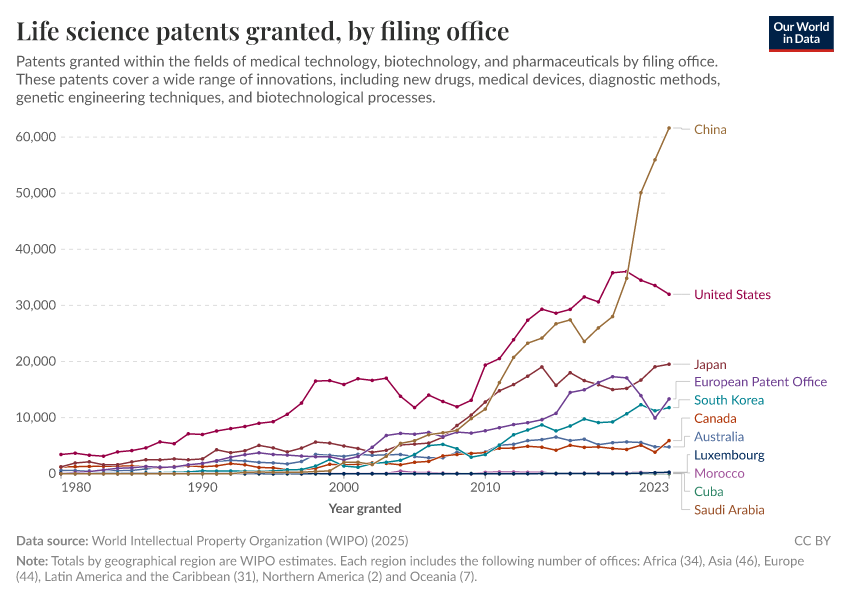Life science patents granted, by filing office

What you should know about this indicator
- Patents are a form of intellectual property that give their holders exclusive rights to an invention for a limited period, typically 20 years from the filing date. It prevents others from making, using, selling, or distributing the patented invention without the patent holder's permission.
- The number of patents granted by a patent office is an indicator of innovation and research activity within a country or region. It is sometimes used as a proxy for technological advancement and economic development, as patents often lead to new products, services, and industries.
- This chart shows patents based on where the patent application was filed. This is typically the national or regional patent office of the region where the intellectual property protection is sought, but does not necessarily mean the inventor was born or lived there.
- Inventors can file patents in national or regional patent offices. Regional patent offices cover multiple countries and issue a single patent that is valid in all member countries (with some exceptions). Patents granted by regional offices are not included in the national totals of the member countries.
What you should know about this indicator
- Patents are a form of intellectual property that give their holders exclusive rights to an invention for a limited period, typically 20 years from the filing date. It prevents others from making, using, selling, or distributing the patented invention without the patent holder's permission.
- The number of patents granted by a patent office is an indicator of innovation and research activity within a country or region. It is sometimes used as a proxy for technological advancement and economic development, as patents often lead to new products, services, and industries.
- This chart shows patents based on where the patent application was filed. This is typically the national or regional patent office of the region where the intellectual property protection is sought, but does not necessarily mean the inventor was born or lived there.
- Inventors can file patents in national or regional patent offices. Regional patent offices cover multiple countries and issue a single patent that is valid in all member countries (with some exceptions). Patents granted by regional offices are not included in the national totals of the member countries.
Sources and processing
This data is based on the following sources
How we process data at Our World in Data
All data and visualizations on Our World in Data rely on data sourced from one or several original data providers. Preparing this original data involves several processing steps. Depending on the data, this can include standardizing country names and world region definitions, converting units, calculating derived indicators such as per capita measures, as well as adding or adapting metadata such as the name or the description given to an indicator.
At the link below you can find a detailed description of the structure of our data pipeline, including links to all the code used to prepare data across Our World in Data.
Reuse this work
- All data produced by third-party providers and made available by Our World in Data are subject to the license terms from the original providers. Our work would not be possible without the data providers we rely on, so we ask you to always cite them appropriately (see below). This is crucial to allow data providers to continue doing their work, enhancing, maintaining and updating valuable data.
- All data, visualizations, and code produced by Our World in Data are completely open access under the Creative Commons BY license. You have the permission to use, distribute, and reproduce these in any medium, provided the source and authors are credited.
Citations
How to cite this page
To cite this page overall, including any descriptions, FAQs or explanations of the data authored by Our World in Data, please use the following citation:
“Data Page: Life science patents granted, by filing office”. Our World in Data (2025). Data adapted from World Intellectual Property Organization (WIPO). Retrieved from https://archive.ourworldindata.org/20251031-120222/grapher/medicine-and-biotechnology-patents-granted-by-filing-office.html [online resource] (archived on October 31, 2025).How to cite this data
In-line citationIf you have limited space (e.g. in data visualizations), you can use this abbreviated in-line citation:
World Intellectual Property Organization (WIPO) (2025) – processed by Our World in DataFull citation
World Intellectual Property Organization (WIPO) (2025) – processed by Our World in Data. “Life science patents granted, by filing office” [dataset]. World Intellectual Property Organization (WIPO), “World Intellectual Property Organization - Patents 2025-05-01” [original data]. Retrieved November 5, 2025 from https://archive.ourworldindata.org/20251031-120222/grapher/medicine-and-biotechnology-patents-granted-by-filing-office.html (archived on October 31, 2025).